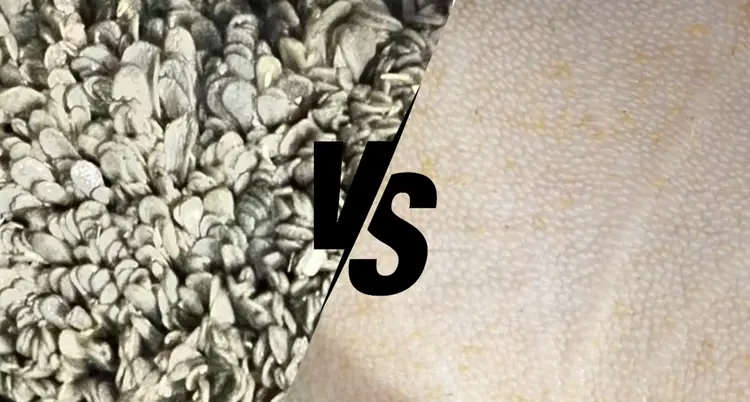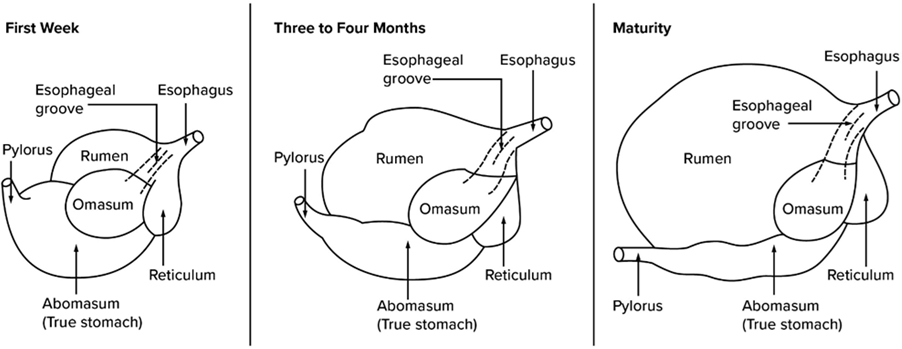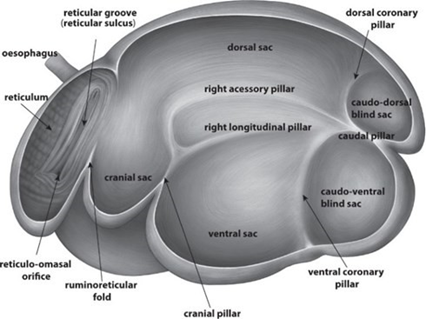Optimizing Rumen Development: Key Factors for Healthy Digestive Growth
Cellulose is the most abundant carbohydrate on earth and can’t be used by any mammal as they cannot produce the enzyme cellulase that can break down cellulose and lignin into simple sugars. Ruminants are specially designed to utilize cellulose; ruminants live in a symbiotic relationship with the rumen microbes. The rumen microbes can ferment and break down these structural carbohydrates into volatile fatty acids (VFA) that can be utilized by the animal. This process, however, takes time, so it needs more space than a glandular stomach. The rumen takes up to 80% of the abdominal cavity and contributes to approximately 20% of the animal’s live weight. This makes the rumen the most important organ in the body.

Rumen development is essential for optimal digestion, nutrient absorption, and overall health in ruminants. A well-developed rumen supports microbial fermentation, breaking down complex carbohydrates into VFA’s, the primary energy source for ruminants. Efficient VFA absorption, facilitated by well-developed rumen papillae, improves feed efficiency and reduces the risk of metabolic disorders such as acidosis. Additionally, a strong rumen epithelium acts as a barrier against pathogens, reducing the risk of infections and inflammation. Ultimately, better rumen development leads to improved performance in animals and better profitability.
The anatomy and function of the gastrointestinal tract
A ruminant’s stomach is a specialized, multi-chambered organ designed to efficiently digest fibrous plant material. Unlike monogastric animals, ruminants, such as cows, sheep, and goats, have four distinct stomach compartments: the rumen, reticulum, omasum, and abomasum. The rumen is the largest organ in the gastrointestinal tract, taking up ±80% of the abdominal cavity and contributing to approximately 20% of the animal’s live weight. Serves as the primary fermentation fat, where microbes break down complex plant fibres into volatile fatty acids and gasses. The reticulum aids in the further breakdown of food and acts as a sorting area, while the omasum absorbs water and nutrients. Finally, the abomasum functions similarly to a monogastric stomach, where enzymatic digestion of proteins takes place. This complex system allows ruminants to efficiently extract nutrients from tough plant material, supporting their unique diet.

The surface structures of the four stomach compartments in ruminants are uniquely adapted to their specific functions in digestion.
1. Rumen
The rumen's inner surface is covered with papillae (finger-like projections), which increase the surface area for the absorption of volatile fatty acids (VFAs) produced during fermentation. The papillae are densely arranged and help in the absorption of nutrients, providing a large surface area for microbial action and nutrient uptake.
2. Reticulum
The reticulum has a honeycomb-like pattern, with hexagonal cells that help trap and process food. This structure aids in the separation of smaller particles from larger ones and helps move ingesta back into the rumen for further fermentation (regurgitation) or toward the omasum.
3. Omasum
The omasum has many layers of folds, or laminae, that resemble pages of a book. These folds increase the surface area for absorption of water, nutrients, and VFAs. The surface is smooth, but the structure itself allows efficient passage and absorption of digested material.
4. Abomasum
The inner surface of the abomasum is lined with gastric pits and rugae (folds), which help in the secretion of digestive enzymes and acids. Unlike the other compartments, the abomasum functions similarly to a monogastric stomach with a smooth surface designed for enzymatic digestion.

Together, these specialized surface structures enable ruminants to process and absorb nutrients from plant material, making them uniquely adapted to an herbivorous diet.
Why is a ruminant born with an underdeveloped rumen?
There are mainly 4 reasons why ruminants are born with underdeveloped rumens:
1. During the calving process the calve must squeeze through the narrow pelvic opening. This will either burst the rumen or the rumen fluid will be regurgitated and contaminate the birth canal.
2. When the animal is born the rumen is sterile, it would not be possible to populate the rumen with rumen microbes while the newborn is in utero.
3. With a fully developed rumen, there will be no esophageal groove. The colostrum will have to enter the rumen, in the rumen the colostrum will be either diluted by the rumen fluid or destroyed by the rumen microbes. With a fully developed rumen at birth there will be no colostral immunity.
4. It takes 12 to 24 hours for the rumen to produce and absorb nutrients. Even if the rumen is developed and populated with microbes at birth, the neonate will not be able to get enough dry matter intake fast enough to sustain life.
Rumen Development
When a ruminant is born, it is born with an underdeveloped rumen and reticulum. The neonate is essentially a monogastric concerning its gastrointestinal system. The relative size and development of the forestomach compartments in ruminants change significantly with age. At birth, the rumen and reticulum are small, nonfunctional, and account for only 39% of the total stomach volume. These compartments lack microorganisms, and the rumen papillae and the omasum folds are still undeveloped. In this phase of life, the calf’s largest stomach compartment is the abomasum, constituting more than 50% of the total stomach area. The rumen wall is very thin with limited muscularization and blood supply, and there are also minimal to no rumen papillae present.
The rumen and reticulum will remain undeveloped and nonfunctional as long as the diet is restricted to milk. There is a structure called the oesophageal groove located in the reticulum wall that allows milk to bypass the rumen and directly enter the omasum and abomasum. The calf's nursing behaviour causes a reflex action that closes the oesophageal groove, which prevents milk from entering the rumen.
The size of the rumen (the volume) drastically increases from birth with a massive growth spurt, significantly faster than the rest of the body. In the first weeks after birth the animal will get sufficient nutrition from the milk, but as the milk volume and density starts to decrease the young animal must get more and more absorbable nutrients from the rumen to make up for the shortage of milk.

The greatest influence on rumen size and muscularization is the physical structure of the feed. To increase the rumen size, the feed must have a larger particle size and highly effective fibre to increase the physical stimulation of the rumen wall. This scratch factor will subsequently increase the rumen volume, the muscle in the rumen wall and the motility thereof. The physical structure of the feed will also help the rumen to increase the muscularization (the process of smooth muscle cell accumulation) of the rumen wall and will increase blood supply to the rumen wall. A study showed that calves that were fed only milk showed signs of rumen motility at 10 weeks of age, calves that received sponges showed signs of motility at 7 weeks of age, but calves that received a grain-based diet showed signs of rumen motility at three weeks of age. We can, therefore, conclude that motility is not only a function of muscle development but that the nutrient value of the feed also plays a role. With the increased muscularization of the rumen wall, we automatically get an increase in blood supply. The increased blood supply plays a critical role in oxygen and nutrient supply to the muscles, but they must also absorb and transfer the nutrients from the digestive tract to the body.
The rumen has five distinct yet connected compartments that create different niche environments. These subregions' development is incorporated with the development of the rumen size. They have different fermentative profiles based on their microbial activity in these compartments. The microbe composition will change based on these subregions, helping to improve efficient food digestion that will impact the diversity of microbial populations inhabiting these regions. The environmental conditions of the rumen sacs continually fluctuate due to ruminal contractions, stratification and the digestibility of feedstuffs.

Together with the size and the muscularization of the rumen wall, we get rumen microbial colonization. The establishment of the rumen microbiome is critical to host metabolism, health, and immune development. The rumen is sterile before the animal is born, but the first colonization takes place during birth, where the calve ingests the microbiota from the fluid present during natural birth. There are two important aspects when it comes to microbial colonization: the amount of rumen microbes is dependent on the substrate available for them to feed on, and they need a watery environment. It is, therefore, important that the animal is fed creep feed of the right structure and nutrient balance and has free access to water. Without water intake, the rumen cannot develop; it is, therefore, important to make sure the animals can reach the water trough. Microbial composition shifts and gets more complex with age and development of the animal and tends to stabilize with weaning and maturity.
To increase the rumen absorption surface, we need papillae proliferation. The volume of the rumen and papillae proliferation can develop independently from one another. Rumen papillae play a crucial role in nutrient absorption, particularly volatile fatty acids produced during fermentation. When microbes in the rumen ferment carbohydrates, they produce mainly acetate, propionate, and butyrate, which are then absorbed through the rumen wall and used as energy sources. Volatile fatty acids (VFAs) are a primary energy source for ruminants, supplying approximately 60-80% of their total energy requirements.
• Acetate ![]() Mainly used for energy and fat synthesis.
Mainly used for energy and fat synthesis.
• Propionate ![]() A key precursor for gluconeogenesis in the liver, contributing directly to glucose supply.
A key precursor for gluconeogenesis in the liver, contributing directly to glucose supply.
• Butyrate ![]() Utilized primarily by the rumen wall for and body energy and plays a role in stimulating papilla
Utilized primarily by the rumen wall for and body energy and plays a role in stimulating papilla
proliferation.
To get papillae proliferation, we need to increase the butyrate production by rumen microbes. The balance of VFA’s is influenced by the diet composition, butyrate is mainly produced by microbes that ferment sugars and starch. To have papillae proliferation from an early age, it is necessary to introduce creep feed. Rumen papillae can degenerate if there is not a constant supply of VFA’s produced by the rumen microbes; it is, therefor, important to keep a continuous feeding program to grow and maintain the rumen papillae. Rumen papillae can grow in length, width and density, this is all important to increase the surface area of the rumen wall for a larger absorption area. With a greater surface area, we decrease the risk of acidosis as there is more surface area for VFA’s to be absorbed. The growth of the papillae will also increase the thickness of the rumen wall to lower the risk of endotoxin translocation, preventing systemic inflammation and liver abscesses.
|
To optimize rumen development, the following is important: |
|
|
Increase rumen size |
Physical structure of the feed - feed must have a larger particle size and highly effective fibre to increase the physical stimulation of the rumen wall. |
|
Increase rumen muscularization |
Physical structure and the nutrient composition of the feed |
|
Increase rumen blood supply |
Will be as result of the increase rumen muscularization |
|
Increased enervation |
Is controlled by the vagus nerve |
|
Rumen microbial colonization |
Need sufficient and continuous intake of the correct feed as sub- strate for the microbes. Water intake |
|
Increase epithelial development |
Increased production of VFA’s by the rumen microbes |
|
Increase papillary development |
Increased production of VFA’s, especially butyrate, by the rumen microbes. |
|
Rumen pillars and groves |
Development is incorporated in the development of the rumen size. |
If you want to learn more about optimizing rumen Development, please contact a De Heus technical advisor for expert guidance - https://www.deheus.co.za/meet-our-team/.
